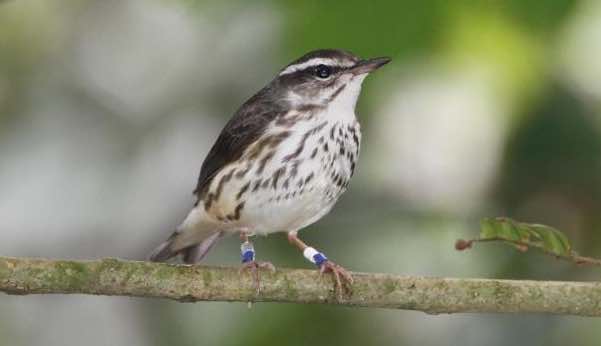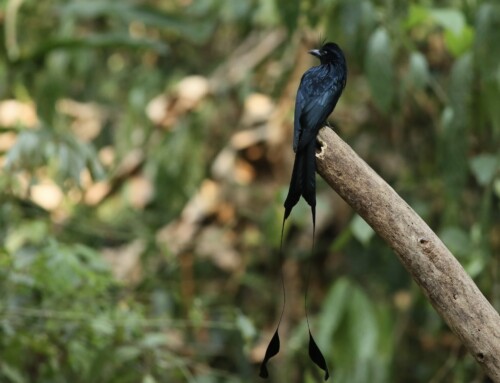Not only can effects of conditions on the breeding grounds carry over to the wintering grounds, they can be extended and accumulate over time
LINKED PAPER
Carry-over effects provide linkages across the annual cycle of a Neotropical migratory bird, the Louisiana Waterthrush Parkesia motacilla. Latta, S.C., Cabezas, S., Mejia, D.A., Paulino, M.M., Almonte, H., Miller-Butterworth, C.M. & Bortolotti, G.R. 2016. Ibis. DOI: 10.1111/ibi.12344. View
Migratory birds, many of which are declining in population size, face unique challenges throughout the annual cycle which affect survival and reproductive success. A general model for understanding the demography of North American migratory birds (Sherry & Holmes 1995) suggests that migrant bird populations can be limited by conditions on either the breeding or wintering grounds, or by factors that occur during migration. The model emphasizes the importance of density dependence and variation in habitat quality on the rates of reproduction and survival. In one of the only tests of the Sherry and Holmes (1995) model, Latta and Faaborg (2002) linked population responses and individual condition of wintering Cape May Warblers Setophaga tigrina to prevailing ecological conditions across three habitats to show how demography interacts with habitat quality, mediated by foraging ecology, to limit populations. A population response to differences in habitat quality was observed through differences in foraging behavior, sex- and age-class segregation, and among-habitat differences in the survival indices of overwinter site persistence and annual return rate.
Population limitation in migratory birds may also involve carry-over effects between seasons. Variation in conditions at one point in life may have future implications for fitness and population growth rates (Metcalfe & Monaghan 2001), and these effects can manifest themselves between seasons (Norris 2005). Carry-over effects thus refer to events and processes occurring in one season that result in individuals making the transition between seasons in different states or levels of condition, thereby affecting individual performance in a subsequent period (Inger et al. 2010, Harrison et al. 2011). Carry-over effects may directly impact individual fitness, and may affect population dynamics if body condition or stress levels influence survival or reproductive success.
A number of theoretical models predict how carry-over effects from the wintering to the breeding grounds might influence population dynamics through changes in reproductive success (Norris 2005, Ratikainen et al. 2008). This has been shown, for example, in the American Redstart Setophaga ruticilla, where stable isotope analyses indicated winter habitat quality of individuals arriving on the breeding grounds (Marra et al. 1998), and suggested that birds from inferior-quality scrub habitat arrived on the breeding grounds later in the spring and produced fewer young (Norris et al. 2004). However, carry-over effects from the breeding to the wintering grounds are less often recognized (Inger et al. 2010, Harrison et al. 2011), in part because of the difficulty of assessing physiological condition and tracking individual birds across seasons.

In this study from the Cordillera Septentrional of the Dominican Republic, we investigated whether carry-over effects provide linkages across the annual cycle of a Neotropical migratory bird, the Louisiana Waterthrush Parkesia motacilla (hereafter LOWA). The LOWA is a small (~20 g), stream-obligate bird with behavioral dominance resulting in some individuals obtaining higher quality territories than other individuals on both the breeding- (Robinson 1995, Mulvihill et al. 2008) and wintering-grounds (Master et al. 2002, Hallworth et al. 2011). We used feather corticosterone (CORT) levels of LOWA as a measure of the physiological state of the bird at the time of moult on the breeding territory, although it remains unknown what specific cause(s) are responsible for variation in CORT.

Below An index of body condition is determined for each individual by using the unstandardized residuals of the regression between log10 of bird mass and log10 of the wing chord. We show that body condition was important in determining whether adult birds returned to the wintering grounds in the subsequent year © Danilo A. Mejía.
We show that birds arriving on wintering grounds with lower CORT scores, indicating reduced energetic challenges or stressors, occupied higher quality territories, and we show that these birds then achieved a better body condition during the overwinter period. Body condition, in turn, was important in determining whether adult birds returned to the wintering grounds in the subsequent year, with birds in better condition returning at greater rates. Together these data suggest a carry-over effect from the breeding grounds to the wintering grounds that is further extended with respect to annual return rates.

Very few other studies have reported events occurring during the previous breeding season with latent effects during the subsequent overwintering period or on annual survival. This study shows that the effects of variation in energetic challenges or stressors can potentially carry over from the natal stream and accumulate over more than one life-history period before manifesting in reduced survival. This is of particular interest in building models of population limitation of migratory birds, and ultimately in crafting conservation plans for declining populations of migratory birds.
References
Harrison, X.A., Blount, J.D., Inger, R., Norris, D.R. & Bearhop, S. 2011. Carry-over effects as drivers of fitness differences in animals. J. Anim. Ecol. 80: 4-18. View
Inger, R., Harrison, X.A., Ruxton, G.D., Newton, J., Colhoun, K., Gudmundsson, G.A., McElwaine, G., Pickford, M., Hodgson D. & Bearhop, S. 2010. Carry-over effects reveal reproductive costs in a long-distance migrant. J. Anim. Ecol. 79: 974-982. View
Latta, S.C. & Faaborg, J. 2002. Demographic and population responses of Cape May Warblers wintering in multiple habitats. Ecology 83: 2502-2515. View
Marra, P.P., Hobson, K.A. & Holmes, R.T. 1998. Linking winter and summer events in a migratory bird by using stable-carbon isotopes. Science 282: 1884-1886. View
Metcalfe, N.B. & Monaghan, P. 2001. Compensation for a bad start: grow now, pay later? Trends Ecol. Evol. 16: 254-260. View
Mulvihill, R.S., Newell, F.L. & Latta, S.C. 2008. Effects of acidification on the breeding ecology of a stream-dependent songbird, the Louisiana Waterthrush (Seiurus motacilla). Freshwater Biol. 53: 2158-2169. View
Norris, D.R. 2005. Carry-over effects and habitat quality in migratory populations. Oikos 109: 178-186. View
Norris, D.R., Marra, P.P., Kyser, T.K., Sherry, T.W. & Ratcliffe, L.M. 2004. Tropical winter habitat limits reproduction success in a migratory bird. Proc. Roy. Soc. Lond B Biol. Sci. 271: 59-64. View
Ratikainen, I.I., Gill, J.A., Gunnarsson, T.G., Sutherland, W.J. & Kokko, H. 2008. When density dependence is not instantaneous: theoretical developments and management implications. Ecol. Lett. 11: 184-198. View
Robinson, D.W. 1995. Louisiana waterthrush (Seiurus motacilla). The Academy of Natural Sciences, Philadelphia, PA and American Ornithologists’ Union, Washington, D.C.
Sherry, T.W. & Holmes, R.T. 1995. Summer versus winter limitation of populations: what are the issues and what is the evidence? In: Ecology and management of Neotropical migratory birds (eds Martin, T.E. & Finch, D.M.). Oxford University Press, New York, pp 85-120.
Image credit
Featured image: Louisiana Waterthrush © José M. Pantaleon.
If you want to write about your research in #theBOUblog, then please see here.







